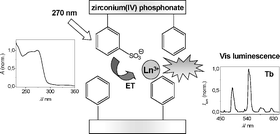Zirconium organophosphonates as photoactive and hydrophobic host materials for sensitized luminescence of Eu(iii), Tb(iii), Sm(iii) and Dy(iii)†
Abstract
Novel luminescent materials based on lanthanides [Eu(III), Tb(III), Sm(III), and Dy(III)] and a mixed zirconium phenyl- and m-sulfophenyl phosphonate as the host matrix, have been prepared and photophysically characterized. Powder X-ray diffraction, 31P-MAS-NMR spectroscopy, IR spectroscopy, and diffuse-reflectance UV spectroscopy revealed the specificity of these materials such as a layered structure, the presence of phenyl groups in the galleries, and the ability to absorb lanthanide ions introduced by simple ion exchange. Characteristic line-shaped long-lived luminescence [ca. 0.27 ms for Eu(III), 0.80 ms for Tb(III), and 0.05 ms for Sm(III)] was observed for different lanthanide ions, and was demonstrated to be generated by an antenna-induced energy transfer process to the metal. The overall luminescence quantum yield of europium- or terbium-loaded materials was measured to be ca. 0.3%. A detailed analysis of the Eu(III) luminescence spectrum and H2O/D2O exchange experiments indicated the presence of ca. 3 water molecules around each lanthanide. Based on the high maximum coordination numbers of lanthanides, up to 9 for free Eu(III) in aqueous solutions, and the presence of only monodentate sulfonate binding sites, more water could be expected. This observation is explained by the rather hydrophobic microenvironment in the interlamellar space of the materials, due to pendant organic moieties, that is, the phenyl groups.


 Please wait while we load your content...
Please wait while we load your content...